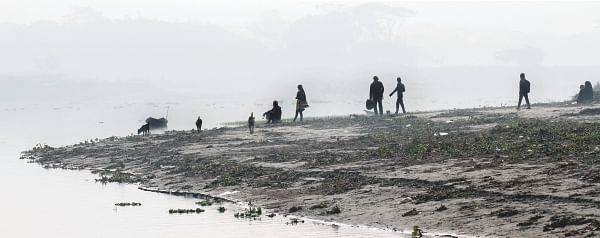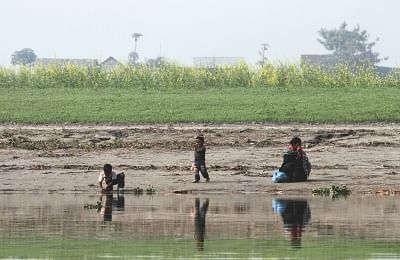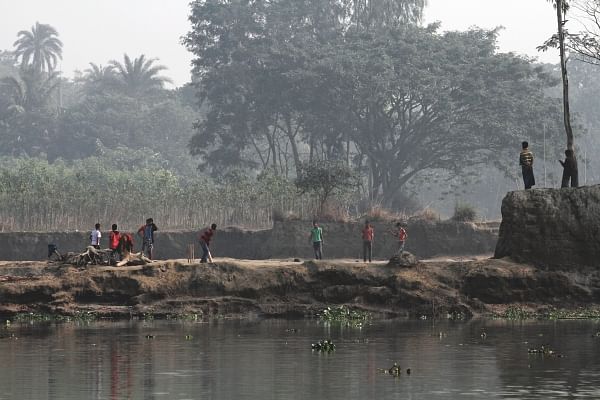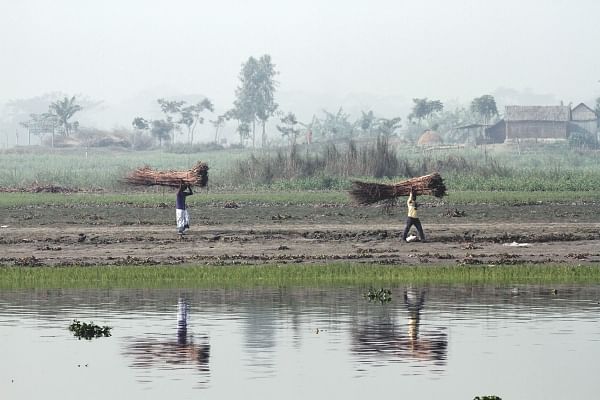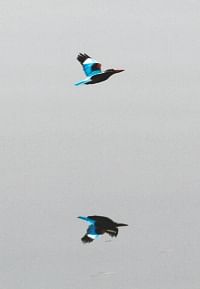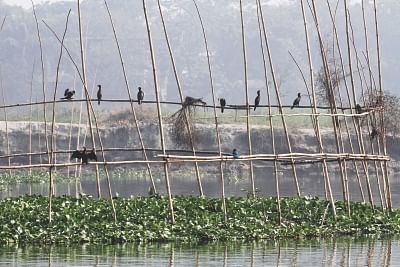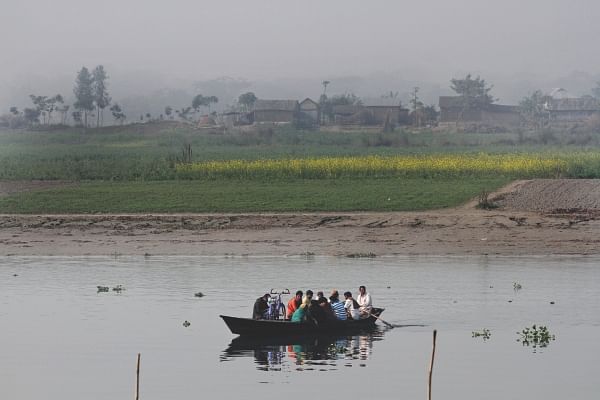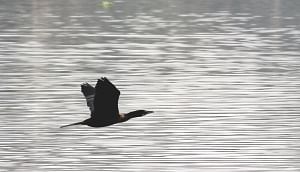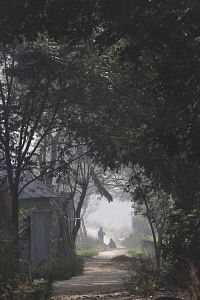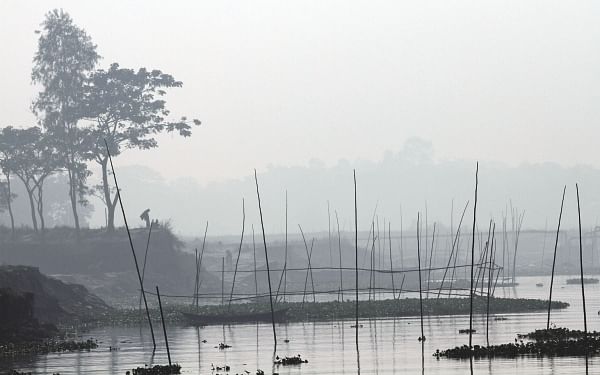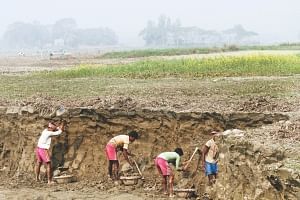| Home - Back Issues - The Team - Contact Us |
 |
| Volume 12 |Issue 03| January 18, 2013 | |
|
|
Cover Story
A Jewel Called Dhaleshwari The Dhaleshwari is the only river around Dhaka that is, till today, spared from the wrath of pollution. The 160-kilometre long river originating from the river Jamuna in the northwestern tip of Tangail district, winds its way for 40 kilometres around Dhaka and merges with the Meghna in the downstream. The Dhaleshwari has been lucky so far. The river's banks are yet to witness the mindless industrialisation that generally unleashes the worst nightmares for the rivers and people living along it. Morshed Ali Khan Photos: Amirul Rajiv
One has to see to believe the benefits of an unpolluted river. Hardly 30 minutes from Dhaka, in Keraniganj, the river Dhaleshwari offers a rare glimpse of unpolluted nature. In winter, as the water flow slows down, it becomes crystal clear, exposing several feet into its depth. From the beginning of the winter, anglers, from different parts of the country converge on the banks of the river for mainly pikes, curbs and eels. Throughout the night anglers can be found on both banks of the Dhaleshwari, fishing in dotted lights of kerosene lanterns. Catches are good too. Many are rewarded with curbs weighing up to eight kilograms each and pike (Wallago Attu or boal) catches could weigh up to 20 kilograms or more. Last year Kabir, an angler from Paragram hooked a record 23-kilogram boal and sold it instantly for Tk 10,000. Another attraction in the angling world around Dhaleshwari is the near-extinct river kali-baus, a fish in the curb family that in the past thrived abundantly in our rivers. Hooking kali-baus is rare but this year, to the delight of the anglers, many have reported big catches of this species.
For the villagers living on the banks, the river offers not only fresh, unadulterated water but also huge cash incentives. All along the river from the beginning of the winter season, groups of villagers create small pockets of sanctuaries (locally known as chata) with tree branches dumped into the river and earmarked by bamboo poles. Villagers say all sorts of river fish as well as prawns, lobsters, curbs and eels take refuge in the sanctuary. During winter, each sanctuary is harvested two ro three times. And each harvest brings hefty incentives for the groups. Ansar Ali, a farmer from Goaduri village says that last year his group of 10 neighbours made a profit of Tk three lakh from one single chata. The culture of catching bulks of river fish in chatas can be traced back to centuries especially in Dhaka and its adjacent areas. Villagers say as the number of river fish is decreasing, nowadays the chata owners feed the fish regularly to attract more.
“There is a big demand for Dhaleshwari fish in the area with all these rich people who made so much money with land prices rocketing,” Ansar says with a smile, adding, “Of course fish in this river are extremely delicious.”
Ansar recalls his childhood and says how the river has changed its course over the years. He points his finger at the horizon in the west and says the Dhaleshwari flowed miles away from where it is today. “Believe me, in those days fish was so abundant in this river that no one in the villages along this river bought fish from the market, all we did was cast our net and get enough fish for the day,” he adds. For the local farmers, the soil along the river Dhaleshwari is simply ideal for growing anything. Thoroughly recharged by rich coats of silt every year during the flood season, the agricultural fields produce a huge amount of winter vegetables for ready city markets within reach. Farmers along the river say they do not even need fertilizer to grow vegetables. Karizon, her husband Selim Sheikh and their school-going son, Hobby (12) and daughter Bilkis (14), grow vegetables on a rented agricultural plot by the river. Karizon says all family members give time to the family venture next to their house. Karizon says every year during winter they grow at least five varieties of vegetables which include gourd, beans, aubergine, tomatoes, spinach and okra. “We do not use any fertiliser because the soil is really like gold here but whenever the okras and other vegetables start growing, insects become a big problem and we have to buy some pesticide and mix few drops with the river water and spray,” Karizon says. “We pay for the children's education and our food requirements throughout the year from earnings of our produces,” she adds.
Belal Mia from Maniknagar area, further upstream, is also a farmer. Belal grows a wide range of vegetables. “Because I have to spend on pumps for irrigation from the river, I do not bother to do the harvest myself,” Belal says. “Instead, as soon as the vegetables are mature, I sell my entire vegetable fields to buyers and count my cash not bothering to go through the hassles of hiring labourers, harvesting, washing and then transporting to market.” During the weekends river lovers from Dhaka and local men, women and children descend on the Dhaleshwari. Many are seen swimming and bathing in the clear water — a luxury unimaginable in the rivers Buriganga, Turag, Shitalakshya and Balu during winter season when the waters of these rivers become thick, dark and extremely toxic. Many come here to sit down by the river and watch birds. Cormorants (Pankouri) in all sizes bask on the bamboo poles of the chatas (man-made sanctuaries for fish), occasionally diving and disappearing for upto 120 seconds, chasing the small fish underwater. Pond herons blend into banks, time to time taking a small flight to find fresh fishing ground. Lesser whistling ducks (choto shorali) suddenly emerge from the patches of water hyacinths and merrily exchange gestures with their partners. As the sun sets into the vast char area across the river, howling of jackals become louder and louder. Women from the nearby villages say that they use the river water for even cooking, something now unthinkable elsewhere around big cities. Saima, a mother of three children from Vendighat area says that although they have a tubewell at home, she prefers to do her cooking, specially rice, with the river water.
“The tubewell water has a high count of iron and it discolours the rice and our daily curry so first we fetch the river water and keep it overnight in a drum after treating it with fitkeri (potassium aluminium sulphate) and the following day we cook with it or even drink it,” Saima says. The river is a blessing from God; we bathe, wash and even bathe our cattle in it everyday,” she adds. Saima says ironically the river Dhaleshwari also paves the way for robbers. “Our house is so near the river, as soon as the sun sets we are in constant fear of robbers coming from distant areas on trawlers,” she says, adding, “The other day a gang of about 30 robbers arrived at the ghat late in the night and robbed several houses in the village, when I heard the noise of the trawler, we turned off all lights and kept quiet inside, we could hear the gang walking past our house.” Along the river Dhaleshwari prospective industrialists have not been sitting idle. Further downstream in Syedpur area, near the Dhaleshwari bridges on Dhaka-Mawa road, the government has set up an industrial zone. Although so far, a handful of industries have moved into production there, it is feared that many more will soon follow through.
The contentment of most people along the Dhaleshwari may not last long enough. Upstream, the tannery industries from Hazaribagh are being relocated. Locals fear that tanneries will destroy the Dhaleshwari as they did to the Buriganga, Shitalakshya, Balu and Turag. Although the relocated tanneries would be fitted with central effluent treatment plants, locals refuse to believe that the owners would comply with the law and treat their wastes properly before dumping into the river. “The treatment plants would only be run when the inspectors are around but let me tell you our Dhaleshwari will not be the same when tanneries start to operate here,” says Ansar Ali. In Kharakandi area, Mokles Ali, an elderly farmer accuses the government of doing nothing to stop pollution of the rivers. He says if the river Dhaleshwari becomes polluted, people in the areas will become very angry and will never forgive the people who did it.
Mokles suddenly grows restless. He walks a few paces and then suddenly turns back. “Today when I see the river Buriganga on my way to Dhaka, an unknown fear grips me, I do not want to think even in my dream that one day our Dhaleshwari will be gone in the way Buriganga has,” Mokles says with a sigh.
Sayem Akund, a young member of the local 70- member anglers' association says they would resist any step that might create pollution in the river. “People here are very sensitive about the Dhaleshwari and if any industry becomes the source for its pollution we shall all unite to immediately shut it down,” warns Sayem Akund.
The Dhaleshwari is faced with another menace. Some local people are selling the top soil of the land along the river to brick kiln owners in Munshiganj and elsewhere. In the process, day labourers, deployed by these unscrupulous people, dig huge craters along the river and load their cargo vessel before heading off for the sale. Nuruddin, a farmer in the area says that the brick kiln owners are desperate to procure the top soil for manufacturing bricks for the booming construction sector of Dhaka. “These huge craters could change the course of the river in flood season and also trigger erosion,” Nuruddin says, urging the authorities to take action immediately before it is too late. While unstoppable industrial development creeps into the Dhaleshwari banks, thousands of people living along this pristine river wonder whether their beloved river will survive the impending onslaught. |
||||||||||||||||||||||||
Copyright
(R) thedailystar.net 2013 |
